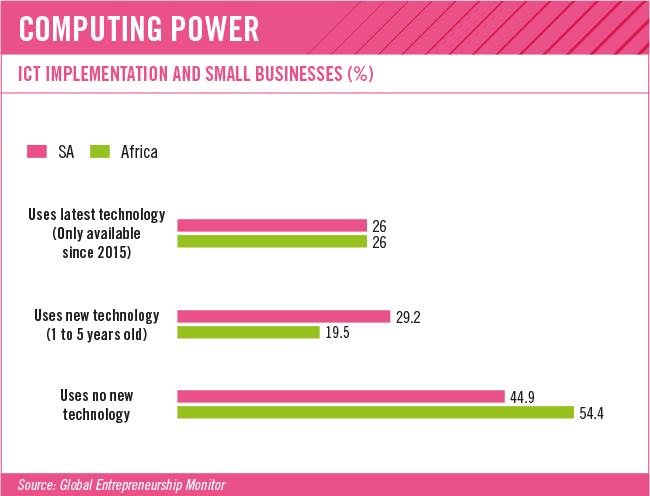It’s one of the best-known – and most feared – statistics in SA’s small-business circles. According to various reports based on mountains of anecdotal evidence, about 70% to 80% of the country’s SMEs are doomed to fail within five years. Launch your own small business today, and it’ll probably be dead and gone long before the next Olympic Games.
Why though? What makes the difference between success and failure for these small firms? This is a question that Christian Friedrich, extraordinary professor at the University of the Western Cape’s School of Business and Finance has been looking into for the past 15 years. ‘Summarising the results of our research, it is obvious that approximately 40% of the success of small-scale businesses is dependent on one thing: the person or entrepreneur who owns the business,’ he wrote in a recent paper.
In a small business of 50 employees or less, says Friedrich, the owner is typically the source of action. ‘He or she is the one making important decisions on products and ways of production, as well as offered services. The business owner deals with important customers, suppliers and employees. The business can rise or fall based on his or her decisions.’
A huge part of the problem is, of course, resources. When it’s just a handful of people doing the work, processing the invoices, contacting the clients and fixing the IT problems, there’s very little capacity left over to try to grow the business. That’s a very real concern for SA’s small-business owners.
In a 2016 survey conducted by the National Small Business Chamber, 52% of respondents said their business employed five people or less. In total, only 19% said they had 11 or more people on their payroll. No wonder, then, that sales and marketing, followed by business and strategic planning, were listed as the most important areas where those small-business owners required urgent assistance.
Damian Michael is an entrepreneur. As MD of Cape Town-based telecoms firm Innovo Networks, he recognises how important it is for SMEs to have access to resources or technologies that enable them to compete with the big guys – and he believes that it’s this barrier to entry that is failing them.
‘An idea or business model is only as good as the systems that drive it,’ he says. ‘And in today’s business climate, the systems leading the way use efficient technology and virtual collaboration.’
Innovo Networks provides voice, data and cloud solutions that aim to help SMEs compete with larger competitors. While breakthrough technologies such as fibre-to-the-business or fibre-to-the-home (for home-run enterprises) are helping bring small businesses up to speed, many SMEs still find themselves hamstrung by costs. ‘Many business owners are not aware that it’s possible to build an integrated office, accessible from anywhere, without building a complicated and expensive network,’ says Michael.
‘It’s all very well to take steps to improve internet connectivity and internet access, but what is also needed is lower costs of the day-to-day use of communication technologies in the small-business sector. It’s the high cost of the virtual infrastructure meant to help businesses streamline their processes that is holding a lot of young start-ups back.’
Cloud computing, mobile apps and a wide range of digital product suites are already helping to change that. Today’s small-business owner doesn’t need their own data servers or massive hardware infrastructure. The cloud, especially, is a potent leveller. And, as Louis Koen – founder of cloud migration firm Crimson Line – points out, with Microsoft’s recent announcement of plans to open cloud data centres in SA in 2018, there has never been a better time for small businesses to take the plunge. Not only will it dramatically impact their IT costs, he says,but securing their critical data will become significantly easier.
‘The reality is that large cloud services, like Microsoft, are financially invested in securing your data and services,’ says Koen. ‘Staying ahead of the security curve is one of their key business requirements. What’s more, should you inadvertently fall prey to malicious software, you can rest easy. Microsoft employs multiple layers of redundancy and backups of information at the data centre level, so it can be restored.
‘This means if you lose your data, either by a breach or by a terminal machine failure, you can request assistance and access all your stored data. Or, if malware has already infiltrated your files, roll back to the last version of your files before the attack.’ Koen adds that we should all backup our devices – a habit that business leaders must continue to encourage.
It used to be that every respectable small business needed an office, a landline and an expensive array of fixed infrastructure. But modern SMEs have the advantage of mobile digital technology that enables employees to connect remotely, and allows the business owner to set up an office space from home – drastically reducing operational costs and enabling higher levels of productivity.
‘Mobility is nothing new,’ says Gavin Meyer, executive director at business solutions provider Itec SA. ‘People have been talking about it and implementing it for years. Today it is about much more, in fact. Small businesses need to realise that the mobility landscape is changing, driven by new technologies that catapult the mobile workforce and separate good mobile workers from the great ones.’ Meyer adds that speed-to-market is the new currency for businesses, and this – together with the wide range of advanced technology applications, products and services – has catapulted the rapid growth of mobility.
‘In light of such technological advancements within mobility, it is critically important for business – especially small businesses – to incorporate and adapt to these technologies to further enhance productivity, resulting in a fully functional, mobile and remote workforce. Through this, businesses are better able to provide their clients with quicker turnaround times and improved service delivery – setting their business apart from others,’ says Meyer.
The benefit of modern digital business tools is that there are so many different options to choose from. Don’t need a 40 Mbps fibre connection? Get the 10 Mbps line instead. Don’t need to migrate every aspect of your business to the cloud? Then don’t. ‘Moving your business into the cloud doesn’t have to be a Big Bang scenario. Opting for just a few of your services, such as email, going onto the cloud can be a way for you to become comfortable before migrating the rest of your IT functions,’ says Koen.
‘Most small companies already make use of payroll services offered over the cloud, with little or no disruption. With personal details and sensitive information like remuneration residing outside the company not being an issue, there is no reason why any business owner should feel any concern about migrating the rest of their digital functions.’
The trick is to know what technology your business needs, and to cut your tech to fit your budget. ‘It’s simple really,’ says Rob Lith, business development director at Connection Telecom. ‘If your digital initiatives don’t align with your business goals, they’re unlikely to benefit you, and may even do more damage than good.
‘Going digital should be about making a process more efficient, reducing its operational cost or adding new value for customers. Ask yourself before investing in anything, what value is there to be gained? Does it streamline operations, enhance your productivity, improve speed-to-market, mobilise your employees, or allow for collaboration between business units or offices?’ If not, he says, then it’s important to weigh those benefits against your cost to company – not just initially, but long term.
Fast, comprehensive, cutting-edge mobile digital technologies can dazzle SMEs, seducing them into over-investing in solutions they don’t need. But that needn’t be the case. Those same technologies can bring significant cost savings. And in a business environment where the odds seem stacked against SMEs, that’s exactly the boost a small business needs to survive, to grow and to succeed.












